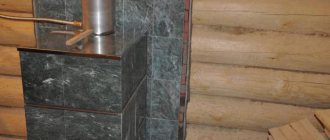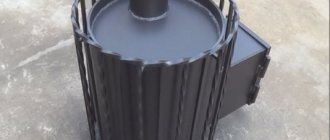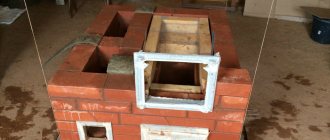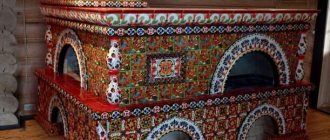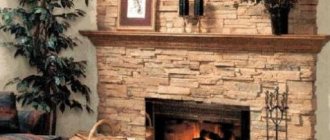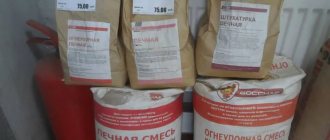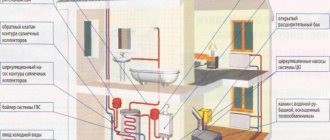Wide range of works
From chimney installation to finishing. You don't have to look for different masters. Our partners will do everything turnkey.
Flexible price
You choose the range of services yourself if, for example, you can properly organize thermal insulation. Save money on this.
RELIABILITY
There is always an agreement regulating the progress of work. After completion of the work, the acceptance certificate is signed.
1 year warranty
If during this time you discover defects caused by the actions of the installers, corrections are carried out at the expense of this team.
KaminDom is a chain of stores where you can not only buy a fireplace or stove, but also order turnkey installation. We will select the necessary materials for you and prepare an estimate for any range of work of varying complexity - installation of a stove, fireplace, chimney, etc.
Leave a request for installation
Types of jobs
Chimney installation
- Installation of a chimney pipe from 18 000 ₽
- Installation of a sandwich chimney from 18 000 ₽
- Installation of a wooden walkway from 4 000 ₽
- Installation of a passage through a wall made of concrete, brick, etc. from 5 000 ₽
- Installation of roof passage and waterproofing from 5 000 ₽
- 1 year labor warranty
Preparatory work
Ideally, a reinforced concrete foundation should be made under the fireplace. If the floors are concrete, you can do without it without any problems. The floor under the fireplace and around it is laid out with porcelain tiles - that’s enough. But in a wooden house there should be at least a monolithic platform. This may be a layer of heat-insulating material. Most often, monolithic minirite sheets with a thickness of 20 mm or more are used for thermal insulation. Porcelain tiles will be laid on top of it.
Porcelain stoneware should be laid joint-to-joint, without seams. The tiles are laid on heat-resistant mastic; standard adhesive for laying tiles will not work! In relation to the dimensions of the fireplace, the porcelain stoneware base should protrude by at least 15 cm on the sides, and in front of the firebox by at least 50 cm. This is necessary for safe operation and protection from accidental fires.
In a wooden house, it is necessary to take care of the thermal insulation of the wall adjacent to the fireplace. The rules for arranging a non-combustible partition dictate fire safety standards to us. Please note that even if the house is brick, if there are wooden structures adjacent to the fireplace or chimney, thermal insulation will also be necessary!
If you decide to install a fireplace above the first floor, then there are a number of restrictions. If the house has wooden floors, then the weight of the completed structure cannot exceed 120 kg, and if it is made of concrete, then 750 kg.
Finishing
- Decorative finishing of the fireplace box from 30 000 ₽
- 1 year labor warranty
Today, saving time is at the forefront, so it is important to receive the full chain of services in one place. We have already spent time searching and checking teams for you who perform work according to a strict algorithm.
Installation stages
Departure of an engineer to measure
Calculation and approval of estimates
Delivery of goods and materials to the site
Installation and commissioning of the facility
Warranty service
Benefit for the buyer
Save time
Today it is important to receive a complete chain of services in one place. We have already spent time searching and checking teams for you.
We think about safety
Stoves, fireplaces and boilers are sources of extreme temperatures up to 750 °C. Special knowledge is required to install such equipment safely and avoid fire.
Making life more convenient
Installation by specialists is fast, safe and free from hassle. You won’t have to calculate the estimate yourself, go for missing materials, and there won’t be any left over. And most importantly , the amount of the estimate is fixed before installation begins and will not be increased during the process.
We comply with warranty conditions
If you encounter any problems with the operation of your stove, boiler or fireplace, please contact the manufacturer. Most manufacturers guarantee the correct functioning of the product only when installed by professionals.
More information about installation work
Types of jobs
Our partners' employees will install a fireplace, stove and other heating equipment, insulate the back wall and floor, and install a chimney with all the necessary thermal protection.
In addition, installers will assemble the lining or firebox, install ventilation grilles, install fire walls made of brick and super-insulation, and provide finishing with tiles or decorative heat-insulating panels.
All work will be carried out in accordance with fire safety rules. All types of installation work are guaranteed for 1 year!
How to order installation?
Leave a request for installation
To order installation or installation consultation, contact us in any convenient way:
- By phone or
- By email
- Via WhatsApp or Telegram
- Write to us in the chat on the website
Our managers will help you figure out the approximate cost of installation and coordinate the time for an engineer to come for an inspection to take measurements and draw up an estimate.
Engineer visit is paid:
- 2500 ₽ up to 100 km from MKAD
- 4000 ₽ from 100 km from MKAD
A nice bonus: the cost of an engineer’s visit is deducted from the total cost during the final installation calculation.
If you want to speed up the process, save time and pay for installation services in full after signing the acceptance certificate, you can inspect the property online.
DIY installation
First you need to know the requirements of fire safety rules SP 7.13130.2013. This is the main document in the Russian Federation used when installing boilers, stoves and fireplaces. Next, you need to understand the amount of materials needed, including fasteners, chimney elements, and even tiles with adhesive. You will also need knowledge of the physical and chemical properties of these materials in order to work and apply them correctly. Don't forget to take at least one assistant. It will be difficult for one person to install a stove and chimney; heating equipment weighs up to 400 kg, and the pipes themselves are only light at first glance. We will be glad if you master the intricacies of installing stoves, fireplaces, and boilers. Perhaps in the future you will become our partner.
Disclaimer
KaminDom is a trading organization; our employees do not perform installation. Only people who do this every day for several years will be experts in this matter. Therefore, we recommend our time-tested partners, carefully select them and do not cooperate with unscrupulous contractors. We are not responsible for the activities of installers, but we try to promptly help in resolving emerging issues. The installation teams are responsible for the quality, timing, cost and payment procedure. Please read the contract before concluding and do not sign the acceptance certificate without inspecting the work performed.
Examples of our work with prices
Furnace piping
In rare cases, a room is heated by a stove due to convection currents. The very status of the device implies the most efficient use of released energy. Therefore, the heating system is supplied with a coolant, which can be water circulating through pipes or air moving under the influence of forced convection. Connecting the coolant channels to the furnace is called piping.
Some problems associated with the installation of a fireplace stove are concentrated in the incorrect installation of the main line. With water heating, circulation is provided by a pump or it is carried out due to natural convection. In the second case, it is important to maintain a certain slope of the line, since a reverse slope will lead to stagnation of liquid. In a closed heating system (case 1), the slope does not matter, but the system has strict requirements for tightness. Even a small amount of trapped air will stop circulation.
The water circuit with which the fireplace stove is equipped has an inlet and an outlet for connection to the main line. If they are not specifically marked, then you must remember that the hot water outlet is located below the cold water inlet.
Heating circuit connection diagram
Piping the air duct is not difficult, but laying the line under the panels or covering it with plasterboard is a labor-intensive process. A furnace that uses air as a coolant is equipped with a fan system that drives air through the main line. By adjusting the supply dampers, you can direct heat selectively to different rooms.
Good to know: How to build a stove for a cauldron from brick, metal and other objects
Turnkey fireplace RUB 245,000
- Firebox Invicta Primo 700 55 000 ₽
- Cladding (custom order) 123 000 ₽
- Chimney Vesuvius (AISI 430) 30 000 ₽
- Insulation and consumables 7 000 ₽
- Installation 50 000 ₽
- First kindling
Types of potbelly stoves
The furnace body can be made of several types of metal:
- become;
- cast iron
When the stove is made of cast iron and heated with wood, we can talk about a very large weight. Warming up such a mass requires time much longer than heating the steel structure.
However, this inertia quickly becomes a positive quality when the oven begins to cool. Steel walls remain hot only in the presence of a combustion process. As soon as it stops, they instantly cool down.
Cast iron cannot cool down so quickly; it will give off heat for quite a long time after the combustion stops and is completely extinguished.
The service life of a cast iron stove is much longer than its metal counterpart. Burnout of the walls occurs very slowly. But unfortunately, there is one significant drawback. If the stove is hit with a heavy object, it may crack and become unsuitable for further use.
The “stove stove” models are available in several types:
- without legs;
- with legs;
- rectangular;
- barrel-shaped.
The most suitable fuel for such a design, according to its manufacturers, is rectangular firewood. There are many more of them in the firebox.
cb678e447e48d3d55624aaee2a5bf068.jpe 575569543b630d3d5e4d27e16a8bd004.jpe ab80d2e71c5bd0767f7505f6bbb68c3e.jpe
When a “potbelly stove” is made with your own hands, it is most often given a barrel-shaped shape.
How and with what to heat a potbelly stove?
Fuel. Steel stoves are designed for wood heating. You can also use sawdust-based fuel briquettes, which are sold in construction shopping centers. Stoves designed to fire coal are made of cast iron.
Operating modes. Most stoves of this type can operate in one of two modes: intense combustion and temperature maintenance. For intense combustion, after adding firewood and closing the oven door, open the ash pan drawer to ensure that the maximum amount of oxygen enters the firebox. To switch the stove to slow burning mode (maintain temperature), add firewood again and close the ash pan drawer. The slow burning time depends on the design of the stove and can reach 8 hours for models equipped with afterburners.
The draft is adjusted using a damper: if there is excess draft, the damper is partially closed.
Remember: you can use the stove in high-burning mode for no more than 2 hours a day!
ADVICE To extend the service life of the stove, experts recommend heating the stove intensively for 15-20 minutes after the slow burning mode: this is necessary to remove soot formed during the slow combustion of fuel.
Expert advice
A few tips from experienced stove makers:
- You should not place chimneys in corners and places where walls intersect, so as not to weaken their strength.
- Before laying a brick smoke duct, you should prepare a row (layer-by-layer) layout for its installation.
- The otter and fluff masonry, which is an integral part of the brick structure, can be reinforced with metal rods or plates.
- You cannot smooth out the internal roughness of a brick pipe with clay. This causes condensation and dampening of the brick.
Installation procedure
Of course, the simplest solution is to order a stove for your dacha with installation. However, installation often costs more than the product itself, and pride can suffer: is an adult really not able to do such a simple job on his own? Let's get acquainted with other people's experience - study the report on the installation of a buleryan stove by one of the regulars of the dacha forum.
A 100-kilogram buleryan was brought into the house.
The first stage is to perform a fireproof cut for the chimney. The wall of the frame house between the posts is carefully drilled out and sheathed with galvanized sheets with an asbestos sheet lining.
Like that.
Next, a support bracket for the chimney was made. Since welding was not available, it was bolted together; The only tools needed were a drill and a grinder. The wall frame had to be strengthened for the bracket; a tee with a container for collecting condensate was immediately installed on it.
Bracket with tee.
By the way: if your site is not electrified, and you don’t want to work with hand tools, renting a diesel generator for your dacha may be a solution. With a power of 2-4 kW, it costs 800-1200 rubles per day.
The inner surface of the wall around the cutting area is prepared for the proximity of a hot stove: it is lined with asbestos sheets and sheathed with galvanization.
Protective screen on the wall surface.
The owner of the stove approached the installation of the base with all seriousness.
- The first layer was thick porcelain stoneware, laid out on a wooden floor and secured with ordinary screws along the edges.
- Asbestos and a thin layer of basalt wool were laid on top.
- The cake was covered with a galvanized sheet, secured around the perimeter with galvanized screws. A low side was made along its perimeter, which will prevent drafts from carrying wood chips and spilled ash throughout the house.
Base assembly.
The oven is connected to the tee through an adapter mounted on heat-resistant silicone sealant.
After installing the adapter.
The last stage is assembling the chimney and fixing it to the wall with clamps. In our case, a sandwich pipe was used; five meter pipes provided the required height, taking into account the distance from the ridge.
Assembled chimney.
Briefly about the main thing...
Chimneys can be single- or double-walled. Based on the material of manufacture, metal, brick structures and structures made of sandwich pipes are distinguished. The last option is optimal for private houses. When installing a chimney, the rules for its placement in the room are observed. Its functionality, as well as the presence of draft in the heating equipment, depends on the correct determination of the diameter and height of the structure.
The installation technology through a wooden and brick wall is the same, but there are some nuances: wood is more susceptible to ignition and requires maximum protection.
During installation, you must comply with fire regulations, and also take into account possible errors. Date: September 25, 2022
Brick cladding
To get rid of the harsh radiation of the metal, the stove can be lined with brick. The work is carried out in the following order:
- A power calculation of the floor is required. The weight of the structure reaches 0.5 tons.
- The distance between the metal wall and the brickwork is up to 8 cm.
- If the floor is wooden, an iron sheet 4 mm thick and asbestos are laid on it.
- Concrete floors do not require additional preparation.
- The wall thickness is half a brick. It is placed on a mixture of cement and sand.
- In each row, holes are left at the height of the brick for air exchange.
The process of installing a stove in a country house with your own hands requires certain skills. Calculations and layout must first be carried out. Knowing the necessary parameters, you need to purchase equipment and install it.
Video description
Video example of professional installation of a metal fireplace in a finished wooden house:
All work can be divided into main stages:
- Construction of the foundation. It is isolated from the foundation of the house, but is poured simultaneously with the latter even before the construction of housing begins. If it is necessary to introduce a fireplace into an already completed structure, craftsmen remove the floor covering and dismantle part of the ceilings. The depth of the pit should reach the freezing line of the soil; a layer of crushed stone and broken brick is formed at the bottom. The finished height of the formwork should exceed the floor level by 10 cm. When pouring the solution, reinforcing ligaments are used, leveled, and waterproofed after hardening.
- Preparing the walls. They are sheathed with insulating materials, often in multilayer form. The sheets are fixed on metal guides, the joints are sealed using adhesive foil tape. An alternative solution for insulation could be additional brickwork laid flush against the wall.
- Fireplace assembly. The masonry is carried out according to the project, starting from the base, using a special heat-resistant mortar. The internal surfaces are formed from refractory bricks, the rest from solid bricks. The components that form the firebox and door are gradually introduced.
Assembling a fireplace in a wooden houseSource et.aviarydecor.com
Formation of the chimney. It can be internal, passing through the ceiling up to the roof, or external, removing combustion products from the fireplace. In the first case, a combination of two pipes inserted into one another is used
At this stage, special attention is paid to sealing.
Floor finishing. The space around the fireplace with a radius of up to 150 cm is protected using non-combustible materials - marble, porcelain stoneware, facing tiles.
A budget finishing solution is metal sheets. But over time they become uneven and give the room a utilitarian look.
Main functions
Today, such models have a variety of styles. When installing them for heating, they also serve as room decoration.
The fuel for such a system is firewood, the length of which does not exceed 25 cm. You can also use other solid fuels. The main purpose of the potbelly stove:
- heating the building;
- cooking;
- interior detail or decorative decoration.
"Burzhuyka" successfully competes with brick and fireplace systems. However, it has one very important advantage: its dimensions are not large. This stove is easy to transport and connect. It is often used outdoors for cooking on a picnic.
When you constantly have to transport the stove to different places, a collapsible design may be the optimal solution. The top cover, which acts as a hob, is removed. The legs are very easy to disassemble and the chimney to be removed. If desired, you can divide the entire stove into several separate sections.
As a result, you don’t need a lot of space to store the stove; it becomes mobile and easy to transport.
Using such a heating device, you don’t have to worry about carbon monoxide getting into the upper respiratory tract. All harmful gas is removed through the chimney
To achieve this effect, it is very important to carry out the correct installation. The stove's power will reach its maximum if you create good draft
Varieties
If you are going to purchase a wood-burning stove, then you will need information about the types of these units. Here's what we can find on sale:
- Steel and cast iron models;
- Units with and without a hob;
- Fireplace and conventional stoves;
- Conventional combustion furnaces and pyrolysis modifications.
The differences between steel and cast iron units are quite obvious - the former are lighter, less reliable and cheaper, while the latter are gigantic in weight, but are distinguished by their durability and long service life.
Such units not only look great in the interior of a country house, but will also allow you to cook directly on them.
An economical wood-burning stove, which includes a hob, is an excellent find for a cozy country house, small cottage or technical room where people constantly work. Here you can cook soup, fry meat, heat a kettle to enjoy a hearty lunch or dinner. In general, a worthy addition for small-sized housing and technical premises.
Long-burning fireplace stoves combine the practicality of heating units and the beauty of classic fireplaces. Such wood-burning units will create a cozy atmosphere in your home with a beautifully burning flame. Relaxing in a house with a fireplace is a pleasure that will be available for minimal money.
Such devices can burn wood in the usual way or by pyrolysis. In the first case, combustion is carried out in a standard mode, with combustion products being removed through the chimney. Pyrolysis furnaces have a fuel afterburning chamber - the pyrolysis products formed during heating and combustion of wood in the main chamber are burned in it. Such furnaces have higher efficiency.
Safety Recommendations
dry firewood and logs
What must be observed for safe operation of the potbelly stove:
- The stove must be installed on a non-combustible base;
- All objects and flammable surfaces must be no closer than 70-80 cm from the stove;
- You should not put more than three kilograms of fuel into the potbelly stove at one time;
- The firebox door should always be closed, except when loading firewood;
- It is prohibited to operate the stove if there is a problem with the exhaust pipe;
- Do not leave the oven running unattended for a long time or in the presence of small children;
- It is forbidden to touch the oven body while it is running or immediately after the flame in it has gone out; the entire surface heats up to a very high temperature;
- Do not leave or keep flammable objects or materials near a working stove.
If all the rules are followed, the potbelly stove will heat the room for a long time.
Power calculation
How to choose the required thermal power?
Here are fairly simple instructions for houses with normalized heat transfer resistance (for the center of the country - approximately 3.2 m2 * C / W).
- The base value is 60 watts of heat per cubic meter.
Please note: for apartments this value is one and a half times less. A private house loses much more heat (in particular, through the floor and roof).
- Each window increases losses by 100 watts, each door by 200.
- In addition, a regional coefficient is introduced:
| Region | Correction factor |
| Crimea, Krasnodar region | 0,8 |
| Moscow and Leningrad regions | 1,2 |
| Far East | 1,5 |
| Yakutia, Chukotka | 2,0 |
So, for a house measuring 3x4 meters with ceilings 240 cm high, equipped with five windows, one door and located in the Moscow region, the heat requirement will be ((3x4x2.4)x60+5x100+200)x1.2=3513 watts (3.5 kW).
Please note: of course, it is worth considering the actual degree of thermal protection of the building. For example, uninsulated country houses made from block containers may well require not 60, but 160 watts per cubic meter of volume for heating.
Properties of sweetener
Isomalt is a new generation carbohydrate that is low in calories. Used as confectionery sugar for making desserts and sweets. Isomalt, obtained from sucrose, has high-quality glazing characteristics and protects the product from clumping and caking.
The substance is a white crystallized powder. It has a sweet taste and is easily soluble in liquid. Isomalt is an odorless product. It is safe for the human body, since the source of production is one hundred percent natural. Isomalt is obtained from sucrose, which is extracted from starch, cane, honey and sugar beets.
It is commercially available in the form of powder, homogeneous granules or grains of different sizes.
The benefits of the sweetener include the following features:
- provides uniform energy supply to the body;
- activates intestinal function;
- does not cause caries;
- probiotic effect normalizes the number of beneficial microorganisms in the intestines;
- has a beneficial effect on the body, creating a feeling of fullness in the stomach.
Due to its low calorie content, the sweetener belongs to the dietary group, which is important for a healthy diet. It is indispensable for diabetes, as a result of which diabetics can eat confectionery and baked goods using Isomalt without harm to their health
Properties of sweetener:
- low-calorie - 100 g Isomalt contains 147 kcal less than sugar;
- low glycemic index, making it possible for diabetics to use the sweetener;
- providing the body with additional energy;
- activation of intestinal function;
- protecting the body from sudden surges in blood sugar.
Isomalt is safe and harmless to the body, helps to reveal even the most delicate flavors of dishes, is pleasant to the taste, and differs little from sugar. The dosage of sweetener recommended by doctors (in its pure form) is 30 g/day.
Design
The old models of “bourgeois” were not very diverse; designers did not pay any attention to them. Usually the owner of such a model himself came up with the appropriate design for it. He gave it a more attractive appearance and sought to improve its functionality.
Today you can use modern options that can decorate your interior. These include:
- art casting;
- colored glaze;
- overlays;
- heat-resistant paints.
Such models, in addition to their original external design, also differ in their shape. They can successfully replace a fireplace in the house. "Potbelly stove" will be able to repeat its classic form.
Traction force
The functioning of the chimney is based on the draft effect, due to which masses of gases move in the direction from the inlet of the pipe to the outlet due to the influx of fresh air from outside. Traction force is a variable quantity; it is influenced by weather conditions: wind direction and speed, outside air temperature, as well as the state of ventilation in the room (fresh air flow).
Signs of traction problems:
- difficulties in lighting a fireplace;
- low burning flame;
- smoke in the room.
To check the smoke shaft for the presence of natural draft, bring a lit candle or match to the firebox of a non-working fireplace:
- the tilt of the flame towards the smoke exhaust channel indicates the correct operation of the circuit;
- if the flame is level, there is no draft;
- the tilt of the flame towards the room warns of the backdraft effect.
It is impossible to operate the fireplace in the absence or reverse draft. Too much thrust leads to a decrease in thermal efficiency and unnecessary waste of fuel.
Causes of traction problems:
- incorrect configuration of the smoke channel;
- its insufficient height or incorrectly selected section;
- chimney blockage;
- lack of fresh air flow from the street.
Conditions for normal functioning of the chimney:
- maximum verticality of the contour;
- smoothness and tightness of walls;
- regular maintenance and cleaning of the smoke exhaust shaft;
- installing a deflector above the pipe;
- ensuring the flow of fresh air (the presence of a separate adjustable air duct from the street or setting window fittings to ventilation mode during operation of the fireplace);
- installation of equipment to provide forced draft.
Simple designs of potbelly stoves
There are several options for potbelly stoves, each of which has a set of both positive and negative properties.
Potbelly stove from a gasoline barrel
As already noted, this version of a homemade metal stove is not durable, but is captivating with its low cost and ease of manufacture. As a rule, it involves placing the barrel in a horizontal position, but you can equip the potbelly stove in the form of a vertically located metal barrel. In the front wall of the barrel, rectangular windows of the firebox and blower are carefully cut out with a grinder; doors are made from the cut out parts (awnings, a handle, a latch lock, and dimensional strips around the perimeter are welded on), which are hung on the corresponding windows of the front wall of the barrel. There is no need to cut through the blower window; instead, at the very bottom of the front wall, it is enough to drill a series of air supply holes with a diameter of about 20 mm. In the rear part of the upper wall of the barrel, several radial cuts are carefully made from the center marked with a core or punch to the size of the future chimney opening. After which the resulting metal petals are bent upward, forming at the same time the opening of the chimney and the semblance of its pipe.
Potbelly stove for a summer residence from a gas cylinder
As a rule, it is equipped with a horizontally located cylinder, the thick-walled metal body of which forms the combustion chamber of the future stove. The end part of the cylinder with the tap is carefully cut off with a grinder, and a firebox door is made from it (canopies, a handle, a lock - latch are welded), which is hung back on the cylinder - the firebox. In one of the side walls of the cylinder, which will become the lower wall of the combustion chamber, a series of holes are drilled in a checkerboard pattern (with a diameter of about 20 - 30 mm, and in increments of about 20 mm). The drilled holes will serve as a kind of permanent grate for the future stove. From below to the cylinder, completely covering the grate, a separately made iron ash box with doors hung on its window is attached (tacked by welding), and the support legs are welded.
Rectangular stove - potbelly stove
The stove body is made in the form of a rectangular welded metal box with a thickness of 3 mm or more, inside of which a horizontal partition made of a sheet of metal of the same thickness is equipped (welded), dividing the internal space into two chambers: the upper, larger part, the firebox, and the lower part, the ash pan. . A grate window is cut into the horizontal partition, which can be equipped in both removable and non-removable versions. In a simpler, non-removable version, the grate is formed by metal rods, laid parallel with some clearance and welded across this window. The removable grate is made in the form of a metal frame according to the size of the grate window, to which the grate bars are welded in parallel with the gap (the gap to the size of the thickness of the rod used). In the front wall of the box, rectangular windows of the combustion chamber and the blower are cut, onto which the corresponding metal doors are hung. The rectangular shape of this stove is convenient in that its upper wall can be additionally equipped with a cooking hole with a burner, and a metal box with sand can be installed on it, which will significantly increase the heat capacity of the stove and smooth out its heat transfer.
Oil fired metal stove
The designs of metal portable stoves, which use waste motor oil as fuel, stand somewhat apart. Their scope of application is quite narrow, and it is determined both by the specific fumes emitted, which are unacceptable in rooms where people stay for a long time, and by the corresponding fuel, which can only be found in quantities sufficient for heating in car garages, car repair shops and industrial enterprises. The design of this stove is relatively simple. It consists of a “pan” - a container for oil with a filler hole, closed with a plug with a throttle to allow air to pass through.
Building regulations
The rules for installation and operation of chimneys are regulated by a number of building regulations:
- SNiP II 35/2.04.05-91/2.01.01-82;
- DBN V.2.5-20-2001 and NPB 252-98;
- GOST 9817-95, etc.
Key aspects:
- combining ventilation and chimney is not recommended;
- It is not allowed to connect the chimney circuit to other communications: electrical wiring, gas mains, etc.;
- a separate smoke exhaust duct must be installed for each gas equipment;
- when two fireplaces (not gas) are located on the same floor, it is allowed to connect them in one smoke exhaust shaft with its obligatory separation by a transverse wall at a height of 75 cm;
- the shaft is installed predominantly vertically (for gas equipment, verticality is required). The maximum permissible deviation coefficient is 30⁰, while the diameter of the slope must be equal to the cross-section of the main vertical contour. The number of pipe bends cannot be more than three, and the length of the horizontal areas must be within 1 meter, with a total of no more than 2 meters;
- the minimum pipe height is 5 meters from the grate to the extreme point;
- the optimal air flow speed is 15-20 m/s.
- to remove soot deposits at the base of the circuit, it is necessary to equip special “pockets” with a depth of at least 25 cm;
- Sagging of the pipeline circuit is not allowed; for this, all its parts must be hermetically joined together, and the pipeline itself is attached to the load-bearing elements of the building;
- To prevent precipitation from getting inside, the pipe is covered with an “umbrella” on top.
Requirements for the height of the chimney shaft:
- For a gable roof: at a distance from the ridge (parapet) of up to 1.5 m - from 50 cm; at a distance of 1.5-3 m - not lower than the height of the ridge; at a distance of more than 3 m - not lower than the edge of a line drawn at an angle of 10⁰ from the roof parapet to the horizon point.
- For flat roofs - more than 1.2 m.
- When leading a pipe through a wall - from 1-1.5 m from the ground.
Requirements for the room in which the fireplace is planned to be installed (SNiP 31-01-2003/31-106-2002/41-01-2003/42-01-2002/42-101-2003):
- Ceiling height - at least 2 m.
- Volume – at least 7.5 m³.
- Availability of a high-quality ventilation system.
